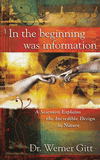
Chapter 7
The Three Forms in which Information Appears
Information accosts us from all sides and presents itself over a wide range of manifestations.
Information accosts us from all sides and presents itself over a wide range of manifestations:
—From messages pounded out by drums in the jungle to telephone conversations by means of communications satellites.
—From the computer-controlled processes for producing synthetic materials to the adaptive control of rolling mills.
—In printed form from telephone directories to the Bible.
—From the technical drawings which specify the construction of a gas-driven engine to the circuit diagram of a large scale integrated computer chip.
—From the hormonal system of an organism to the navigational instincts of migrating birds.
—From the genome of a bacterium to the genetic information inherited by humans.
In addition to the five essential levels of information mentioned in chapter 4 (statistics, syntax, semantics, pragmatics, and apobetics), it is also advantageous to consider a three-fold vertical division of types of information:

Figure 22: Qualitative properties of the sender and his information on the semantic, pragmatic, and apobetic levels. In this diagram we represent the qualitative properties of constructional/creative information, and include both the creative acts of God and human engineering concepts. It is obvious that there is a tight link between the qualitative aspects of the information and the capabilities of the sender. Similar qualitative properties can be formulated for the other two types of information, operational and communication information.
1. Constructional/creative information: This includes all information that is used for the purpose of producing something. Before anything can be made, the originator mobilizes his intelligence, his supply of ideas, his know-how, and his inventiveness to encode his concept in a suitable way. There are many types of encoded blueprints, e.g., technical drawings for the construction of a machine, a cake recipe, details of the chemical processes for synthesizing polyvinyl chloride, an electrical circuit diagram, or the genetic information required for the construction of a living cell.
The criteria for evaluating the searched-for solution are found both in the conceptual stage (semantic aspect of the information) and in the sophistication of the implementation (pragmatics). One or more of the following catchwords characterize these criteria depending on the situation, as shown in Figure 22: underlying functional concept, degree of inventiveness, cleverness of the method of solution, achieved optimality, input strategy, brevity of construction time, applied technology, suitable programming, and degree of miniaturization (e.g., economical use of material and energy). The quality of the visible results (apobetics) can be evaluated in terms of the achieved goal, the efficiency of the input, the ingenuity of the operation, and the certainty of correct functioning (e.g., low susceptibility to interference).
2. Operational information: All concepts having the purpose of maintaining some “industry” in the widest sense of the word are included under this kind of information. Many systems require operational information in the form of programs for proper functioning. These programs are indispensable and ensure that the preconceived processes run as expected. A barrel-organ cannot function without the required cylinder, and the human body is viable only when the conceptual information is provided with all the interactions carried by the nervous system to and from the brain and all the bodily organs. The amount of information streaming through the deliberate as well as all involuntary activities of the human body is about 3 x 1024 bits per day. When this is compared with the total quantity of information stored in all the libraries of the world—1018 bits—we make an astounding discovery: The quantity of information processed in our bodies during the course of one day is one million times greater then all the knowledge represented in the books of the world.
Further examples of operational information as found in technology and in nature:
—the operating system of a computer (e.g., DOS programs),
—the program controlling a robot or a process computer,
—warning systems for airplanes and ships,
—pheromone languages of insects,
—bee dancing (see Figure 39 in appendix A2),
—the hormonal system of the body, and
—operational information in the animal kingdom, which we call “instincts” because of our lack of knowledge about their codes and methods of transfer (e.g., the navigational system of migrating birds as described in appendix A3.4.4.2).
3. Communication information: This is composed of all other kinds of information, e.g., letters, books, phone calls, radio transmissions, bird songs, and the message of the Bible. The apobetic aspect of such information does not include the construction of a product, neither is it involved in maintaining some process. The goals are transmission of a message, spreading joy, amusement, instruction, and personal confidences.
In the Beginning Was Information
Between the covers of this book may well be the most devastating scientific argument against the idea that life could form by natural processes.
Read OnlineRecommended Resources

Answers in Genesis is an apologetics ministry, dedicated to helping Christians defend their faith and proclaim the good news of Jesus Christ.
- Customer Service 800.778.3390
- Available Monday–Friday | 9 AM–5 PM ET
- © 2025 Answers in Genesis


